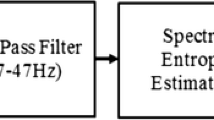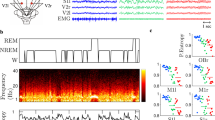Abstract
An effective application is presented of a back-propagation artificial neural network (ANN) in differentiating electro-encephalogram (EEG) power spectra of stressed and normal rats in three sleep-wakefulness stages. The rats were divided into three groups, one subjected to acute heat stress, one subjected to chronic heat stress and one a handling control group. The polygraphic sleep recordings were performed by simultaneous recording of cortical EEG, electro-oculogram (EOG) and electromyogram (EMG) on paper and in digital form on a computer hard disk. The preprocessed EEG signals (after removal of DC components and reduction of base-line movement) were fragmented into 2s artifact-free epochs for the calculation of power spectra. The slow-wave sleep (SWS), rapid eye movement (REM) sleep and awake (AWA) states were analysed separately. The power spectrum data for all three sleep-wake states in the three groups of rats were tested by a back-propagation ANN. The network contained 60 nodes in the input layer, weighted from power spectrum data from 0 to 30 Hz, 18 nodes in the hidden layer and an output node. The ANN was found effective in differentiating the EEG power spectra from stressed to normal spectral patterns following acute (92% in SWS, 85.5% in REM sleep, 91% in AWA state) as well as chronic heat exposure (95.5% in SWS, 93.8% in REM sleep, 98.5% in AWA state).
Similar content being viewed by others
References
Agarwal, R., andGotman, J. (2001): ‘Computer-assisted sleep staging’,IEEE Trans. Biomed. Eng.,48, pp. 1412–1423
Al-Nashash, H. A. M. (1995): ‘A dynamic Fourier series for the compression of ECG using FFT and adaptive coefficient estimate’,Med. Eng. Phys.,17, pp. 197–203
Cervós-Navarro, J., Sharma, H. S., Westman, J., andBongcam-Rudloff, E. (1998): ‘Glial reaction in the central nervous system following heat stress’, inSharma, H. S., andWestman, J. (Eds): ‘Progress in brain research’, vol. 115 (Elsevier, Amsterdam, 1998), pp. 241–274
Chen, J. D. Z., Lin, Z., Wu, Q., andMcCallum, R. W. (1995): ‘Non-invasive identification of gastric contractions from surface electrogastrogram using backpropagation neural networks’,Med. Eng. Phys. 17, pp. 219–225
Dey, P. K. (2000): ‘Involvement of endogenous opiates in heat stress’,Biomedicine,20, pp. 143–148
Dubois, M., Sato, S., Lees, D. E., Bull, J. M., Smith, R., White, B. G., Moore, H., andMacnamara, T. E. (1980): ‘Electroencephalographic changes during whole body hyperthermia in humans’,Electroenceph. Clin. Neurophysiol.,50, pp. 486–495
Goel, V., Brambrink, A. M., Baykal, A., Koeler, R. C., Hanley, D. F., andThakor, N. V. (1996): ‘Dominant frequency analysis of EEG reveals brain's response during injury and recovery’,IEEE Trans. Biomed. Eng.,43, pp. 1083–1092
Hassoun, H. M. (1998): ‘Fundamentals of artificial neural networks’ (Prentice-Hall of India Private Limited, New Delhi, 1998), pp. 35–56
Jandó, G., Seigel, R. M., Horváth, Z., andBuzáki, G. (1993): ‘Pattern recognition of the electroencephalogram by artificial neural networks’,Electroenceph. Clin. Neurophysiol.,86, pp. 100–109
Jervis, B. W., Coelho, M., andMorgan, G. W. (1989): ‘Spectral analysis of EEG responses’,Med. Biol. Eng. Comput.,27, pp. 230–238
Judd, L. L., Britton, K. T., andBraff, D. L. (1994): ‘Mental disorders’ inIsselbacher, K. J.,et al. (Eds): ‘Harrison's principles of internal medicine’, 13th edn, Part 14.4, vol. 2 (McGraw Inc., New York, 1994), chap, 389, pp. 2400–2419
Kulkarni, P. K., Kumar, V., andVerma, H. K. (1997): ‘Diagnostic acceptability of FFT-based ECG data compression’,J. Med. Eng. Tech.,21, pp. 185–189
Lin, S. L., Tasi, Y. J., andLiou, C. Y. (1993): ‘Conscious mental tasks and their EEG signals’,Med. Biol. Eng. Comput.,31, pp. 421–425
Mayer, J. S., andHanda, J. (1967): ‘Cerebral blood flow and metabolism during experimental hyperthermia’,Minn. Med.,50, pp. 33–44
Morimoto, T., Nagao, H., Sano, N., Takahashi, M., andMatsuda, H. (1991): ‘Electroencephalographic study of rat hyperthermic seizures’,Epilepsia,32, pp. 289–293
Nielsen, B., Hyldig, T., Bidstrup, F., Gonzalez-Alonso, J., andChristoffersen, G. R. (2001): ‘Brain activity and fatigue during prolonged exercise in the heat’,Pflugers. Archiv.,442, pp. 41–48
O'Boyle, D. J., Choi, E. W. K., Conroy, G., andTurega, M. (1991): ‘Learned classification of EEG power spectra using a neural network’,J. Physiol., Proc. Physiol. Society, Shaffield Meeting,438, p. 345
Rao, V., andRao, H. (1996): ‘C++ neural networks and fuzzy logic’, 1st edn (BPB Publications, New Delhi, 1996), pp. 123–176
Rosse, R. B., Warden, D. L., andMorihisa, J. M. (1989): ‘Applied electrophysiology’, inKaplan, H. I., andSadock, B. J. (Eds): ‘Comprehensive textbook of psychiatry’, 5th edn, vol. 1 (Williams and Wilkins, Baltimore, 1989), chap. 1.8, pp. 74–85
Rumelhart, D. E., andMcClelland, J. L. (1986): ‘On learning the past tense of English verbs’, inMcClelland, J. L., andRumelhart, D. E. (Eds): ‘Parellel distributed processing: Explorations in the microstructure of cognition’, vol. 2 (M. I. T. Press, Cambridge MA, 1986), pp. 216–268
Rumelhart, D. E., Hinton, G. E., andWilliams, R. J. (1986): ‘Learning representations by back-propagating errors’,Nature,323, pp. 533–536
Sarbadhikari, S. N., andRay, A. K. (1994): ‘Identifying EEG power spectra of depressed rats using a neural network’, inReddy, D. C. (Ed.): ‘Recent advances in biomedical engineering’ (Tata McGraw-Hill, New Delhi, 1994), pp. 76–79
Sarbadhikari, S. N. (1995): ‘A neural network confirms that physical exercise reverses EEG changes in depressed rats’,Med. Eng. Phys.,17, pp. 579–582
Sarbadhikari, S. N., Dey, S., andRay, A. K. (1996): ‘Chronic exercise alters EEG power spectra in an animal model of depression’,Ind. J. Physiol. Pharmacol.,40, pp. 47–57
Sharma, H. S., Westman, J., andNyberg, F. (1998): ‘Pathophysiology of brain edema and cell changes following hyperthermic brain injury’, inSharma, H. S., andWestman, J. (Eds): ‘Progress in brain research’, vol. 115 (Elsevier, Amsterdam, 1998), pp. 351–412
Sirne, R. O., Isaacson, S. I., andD'Attellis, C. E. (1999): ‘A data-reduction process for long-term EEGs’,IEEE Eng. Med. Biol., pp. 56–61
Stearns, S. D., andDavid, R. A. (1988): ‘Signal processing algorithms’ (Prentice Hall of India Inc., Englewood Cliffs, New Jersy, 1988)
Villiers, J. D., andBarnard, E. (1992): ‘Backpropagation neural nets with one and two hidden layers’,IEEE Trans. Neural Netw.,4, pp. 136–141
Webber, W. R. S., Lesser, R. P., Richardson, R. T., andWilson, K. (1996): ‘An approach to seizure detection using an artificial neural network’,Electroenceph. Clin. Neurophysiol. 98, pp. 250–272
Zurada, J. M. (1997): ‘Introduction to artificial neural network systems’ (West Publishing Company, St. Paul, MN, 1997), pp. 163–250.
Author information
Authors and Affiliations
Corresponding author
Rights and permissions
About this article
Cite this article
Sinha, R.K. Artificial neural network detects changes in electro-encephalogram power spectrum of different sleep-wake states in an animal model of heat stress. Med. Biol. Eng. Comput. 41, 595–600 (2003). https://doi.org/10.1007/BF02345323
Received:
Accepted:
Issue Date:
DOI: https://doi.org/10.1007/BF02345323




